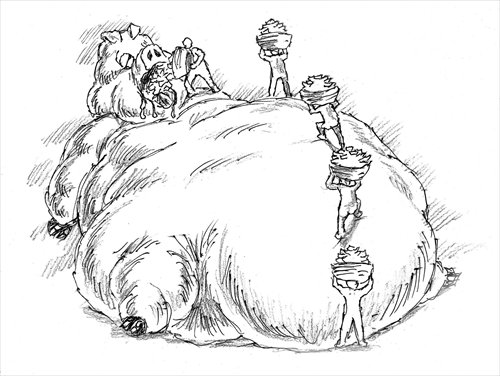Overconsumption could threaten economic stability

Illustration: Peter C. Espina/GT
Recently, the topic of the "middle-income trap" has been discussed frequently by the media and has also drawn attention from economists and experts in China and abroad. Some of them have even concluded that China has already entered the phase of being in a middle-income trap, the same as what happened to some Latin American countries last century. In order to overcome this trap, some experts suggested that China should switch its economic growth model from being export-driven to one driven by domestic consumption. To achieve such a transition, many Chinese local governments have implemented various policies and measures to promote different kinds of consumption. From a short-term perspective, an increase in consumption can be helpful to cut overcapacity. But in the long run, consumption can not serve as a buffer against the problems of overcapacity and the middle-income trap; on the contrary, it might cause a more serious distortion that may affect economic stability.
There are three main types of consumption - government consumption, corporate consumption and private consumption. And statistics show that overconsumption is a common feature of all three categories.
Overconsumption is the result of excessive credit or excessive debt, and it can bring big risks of heavy losses for lenders like banks and other financial institutions.
Over the past few years, the local governments have put large amounts of investment toward projects and public activities. The total amount of local government debt is estimated to be as high as 30 trillion yuan ($4.6 trillion). This could lead to a disaster in the financial sector if the debt cannot be properly settled in the near future. Despite the proposed debt-to-equity swaps, the risk of unpaid debts might still become a reality.
Many Chinese companies have also indulged in overconsumption in overseas markets. In 2015, the value of mergers and acquisitions (M&As) by Chinese companies worldwide stood at around $50 billion, which was financed mainly by credit and loans from banks. This huge M&A volume has triggered doubts overseas. Some foreign investors have commented that these Chinese firms will not be able to pay back their debts, and some foreign partners have even questioned the sources of the Chinese firms' capital. There is also a possibility that some Chinese firms don't have a concrete and detailed business plan for their M&A targets. This could become a potential risk as well.
As for individual consumers, many of them have the habit of following trends, such as the buying spree for Japanese lavatory seats. But normally, most private consumption is paid with credit. In particular, purchases of houses and cars are financed by credit. Meanwhile, some local governments have even announced policies to stimulate and maintain consumption, in effect encouraging overconsumption, in a bid to reduce local overcapacity.
In fact, higher income does not necessarily guarantee higher consumption, and overconsumption doesn't necessarily reflect higher income. This is because overconsumption is based on a higher credit or debt level that could contribute to greater risks to financial stability.
We must be aware that overconsumption could have even more negative effects than overcapacity, and it cannot help to avoid the middle-income trap. It could trigger a credit crisis and this is a risk that no country would like to take.
Now China is in the process of pursuing supply-side reforms, and this will potentially ease the downward pressure on economic growth.
Even though China has become the world's second-largest economy, the country is still not a member of the world's "rich club." Even though China's per capita income has met the middle-income requirement, we still cannot say it is a middle-income country, because "income" itself doesn't tell us its relationship with real consumption. Only the real consumption data can serve as a gauge to measure a country's real income power.
So we should set up our own standard of "real consumption" to examine whether our economy is healthy or not at different points of time, and create new stimulus to boost the real economy.
We have to reflect that one of the main reasons why the US financial crisis spread in 2009 was overconsumption by American people in the previous decades. And the majority of overconsumption was supported by bank credit. Many Chinese at the time admired the so-called American lifestyle, in which future capital was used to enjoy present-day life; but this then created life-long debt burdens.
This kind of overconsumption caused a nightmare for the whole world, and the countries that followed the US model had to tackle the risk of economic collapse. China must try its best to avoid the same route as the US.
In order to meet the challenges including the so-called middle-income trap, China shouldn't give up on the export-driven model, and should maintain consumption at a healthy level that is not excessively credit-dependent. This can ensure that China's economic growth reaches a higher level.
The author is a senior fellow at the Chongyang Institute for Financial Studies at Renmin University of China. bizopinion@globaltimes.com.cn